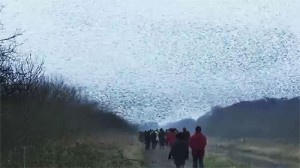The Starling Murmations
 Most amazing natural phenomena like Niagara Falls, the aurora borealis or a beautiful sunset are awe-inspiring, but explainable. The truly stunning phenomena can’t fully be explained. Take the common Starling.
Most amazing natural phenomena like Niagara Falls, the aurora borealis or a beautiful sunset are awe-inspiring, but explainable. The truly stunning phenomena can’t fully be explained. Take the common Starling.
The Starling is small—sized somewhere between a sparrow and a Robin. They weigh less than 3 ounces, have an eight inch wingspan, and are plentiful in North America as well as the British Isles. Viewed singly, the Starling is hardly what one would describe as beautiful. But when seen in conjunction with thousands and thousands of fellow Starlings, this bird is a true wonder to behold.
A group of Starlings is called a murmuration, and even the most jaded nature observer cannot help but be amazed when witnessing a true murmuration. In the attached clip you see the impossibly tight flight patterns of half a million flapping wings forming startling shapes instantaneously like a crazy lava lamp— a swimming whale, a wagging finger, a leaping lion – and that’s just within a few seconds!
Once you accept that what you’re witnessing is not the product of Hollywood CGI, the questions start: Is there a leader bird that decides to break left or right? When do they unanimously decide to roost in the reeds for the night? How does a bird know to react in accordance with an additional hundred thousand starlings within a fraction of a second?
Recently, scientists armed with high-powered video analysis and computational modelings have found that even murmuration is better understood via physics, and not so much biology. According to wired.com, “Starling flocks, it turns out, are best described with equations of ‘critical transitions’ — systems that are poised to tip, to be almost instantly and completely transformed, like metals becoming magnetized or liquid turning to gas. Each starling in a flock is connected to every other. When a flock turns in unison, it’s a phase transition.” That is, for the bird, you have one simple job—move when your neighbor moves. What remains unknown, however, is how they’re able to execute so flawlessly.
As a writer looking for a conflict metaphor, what would happen if one bird, just one errant Starling, turned the wrong way? Would the whole murmuration immediately become disoriented? Would there be catastrophic collisions? Injury? Death?
And if we apply that metaphor to human beings
)